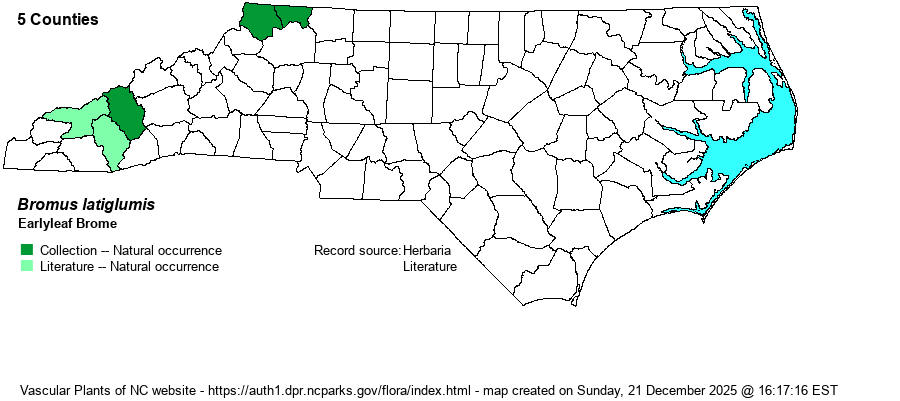| Author | (Shear) A.S. Hitchcock | |
| Distribution | Mountains only, with an apparent gap from Ashe County to Haywood County.
ME to MT south to NC and OK. | |
| Abundance | Rare. The NCNHP database contains only 7 records, all apparently extant, but with no information on population size. This species has an S1 State Rank and is tracked by the NCNHP as Significantly Rare. | |
| Habitat | Along montane rivers in alluvial forests. NC data on plant communities are deficient, but in nearby VA, the habitats are "Well-drained floodplain forests, riverbanks, and mesic upland forests near streams" (Digital Atlas of the Virginia Flora website) -- similar to those in NC. | |
| Phenology | Flowering and fruiting August-October. | |
| Identification | Our native brome grasses typically grow 3-4 feet tall and have open inflorescences with arching branches and drooping spikes. Earlyleaf Brome is readily distinguished by the numerous leaves: 9-20 nodes (vs. 2-9 nodes in our other species). In addition, the leaf sheaths are soft white-hairy. | |
| Taxonomic Comments | This is one of several species split out of the former B. pungans.
Bromus is an important genus of grasses for their value as forage (many species) or for the harm they cause to the guts of grazing animals (a few species). In most of our species, inflorescences arch over and cause the spikelets to droop; thus the plants are often graceful looking. Bromus, Festuca, and Poa all can look quite similar to beginners (and even veterans!), because they all have multi-flowered spikelets. Generally speaking, Bromus taxa have much the largest spikelets, and most Poa taxa have a tuft of wispy hairs at the base of each floret (lacking in the other genera). Bromus and Festuca taxa have obvious awns on the florets that are absent in Poa taxa. With field experience and careful use of keys, one can eventually handle these genera. | |
| Other Common Name(s) | A remarkable number of common names used in the literature -- Riverbank Brome, Auricled Brome, Flanged Brome, Hairy Brome, Ear-leaved Brome, Broad-glumed Brome | |
| State Rank | S1 | |
| Global Rank | G5 | |
| State Status | SR-P | |
| US Status | | |
| USACE-agcp | FACW link |
| USACE-emp | FACW link |

